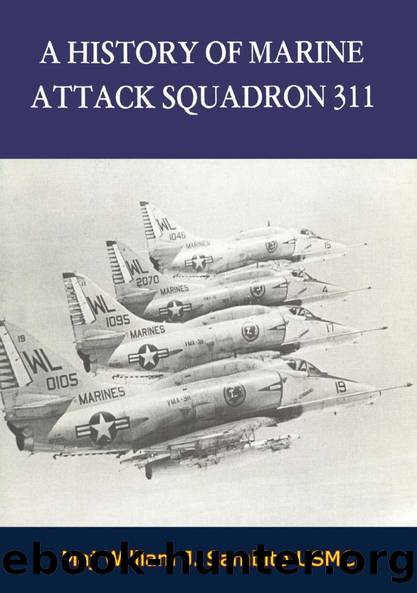A History of Marine Attack Squadron 311 by Maj William J. Sambito USMC U.S. Marine Corps

Author:Maj William J. Sambito USMC, U.S. Marine Corps [Maj William J. Sambito USMC, U.S. Marine Corps]
Language: eng
Format: epub
ISBN: 9781839747700
Barnesnoble:
Publisher: Barakaldo Books
Published: 2021-05-03T00:00:00+00:00
The transition to the new swept-wing fighter went smoothly and by the end of March most pilots had been given the opportunity to try their hand in the new machine. In May the squadron was presented another award to add to its expanding collection, the Air FMFPac Aviation Safety Award for the first quarter of the calendar year 1957. This award was given in recognition of the 2,482 accident-free flight hours accumulated during the period, the unitâs achievements in the 3rd MAW gunnery meet, and the safe accomplishment of the flight training syllabus.
On 11 May, Lieutenant-Colonel Lantz left his post as commanding officer of VMF-311 to become the executive officer of MCAAS Mojave. Upon completion of the Marine Corps Command and Staff School in June, Lieutenant-Colonel Robert E. Smith, Jr., assumed the duties as the new skipper of the Tomcat squadron. Throughout the remainder of May, the squadron made the preparations for its deployment to Mojave where the pilots would be given the opportunity to put the Cougar through its paces on the gunnery and bombing ranges.
On 1 June 1957, the role of 311 as a fighter squadron came to an end when the unit was redesignated Marine Attack Squadron (VMA){140} 311. The redesignation did not require any organizational restructuring, nor did it create any difficulties for the squadron. Rather it simply emphasized a mission that the squadron had already aptly performed both in World War II and in Korea.{141}
After a successful deployment to Mojave, the Tomcats returned to El Toro in late June and settled down to the task of completing the training syllabus in the Cougar. The training went well as the ground crews kept the jets flying and the pilots continued to add to the total of accident-free hours.
By the turn of the year, the Tomcats were ready to show what the F9F-8 could do. The chance came during the last week in February when the squadron deployed again to Mojave. During the 10 flying days deployed, VMA-311 logged 709 sorties totaling nearly 1,030 flying hours. A majority of the assigned pilots qualified in all ordnance phases of the squadron syllabus as they expended over 1,400 bombs, 745 rockets, and 13,000 rounds of 20mm ammunition. Ten pilots who had joined the unit just a few days before it departed for Mojave flew an average of 25 hours and completed the initial familiarization phase of the prescribed syllabus.
Download
This site does not store any files on its server. We only index and link to content provided by other sites. Please contact the content providers to delete copyright contents if any and email us, we'll remove relevant links or contents immediately.
The Radium Girls by Kate Moore(11921)
100 Deadly Skills by Clint Emerson(4840)
Rise and Kill First by Ronen Bergman(4701)
The Templars by Dan Jones(4628)
The Doomsday Machine by Daniel Ellsberg(4415)
The Rape of Nanking by Iris Chang(4136)
Killing England by Bill O'Reilly(3951)
Hitler in Los Angeles by Steven J. Ross(3900)
Stalin by Stephen Kotkin(3875)
12 Strong by Doug Stanton(3508)
Hitler's Monsters by Eric Kurlander(3268)
Blood and Sand by Alex Von Tunzelmann(3138)
The Code Book by Simon Singh(3074)
Darkest Hour by Anthony McCarten(3070)
The Art of War Visualized by Jessica Hagy(2943)
Hitler's Flying Saucers: A Guide to German Flying Discs of the Second World War by Stevens Henry(2714)
Babylon's Ark by Lawrence Anthony(2620)
The Second World Wars by Victor Davis Hanson(2480)
Tobruk by Peter Fitzsimons(2443)
